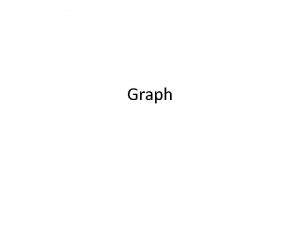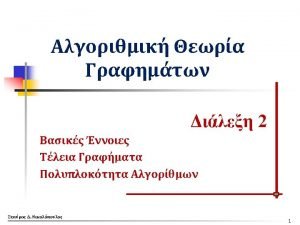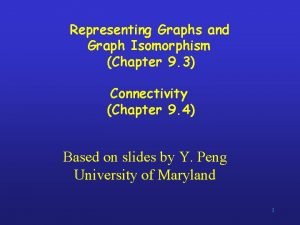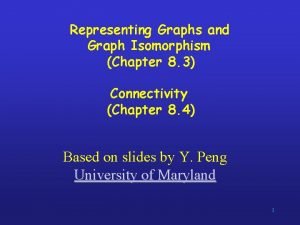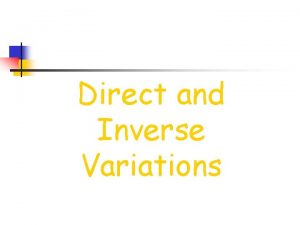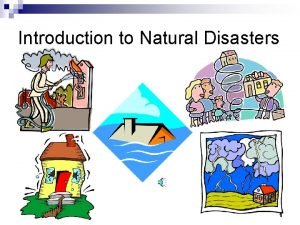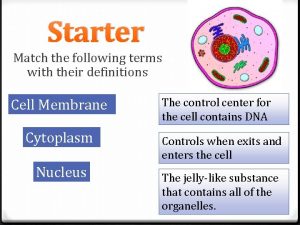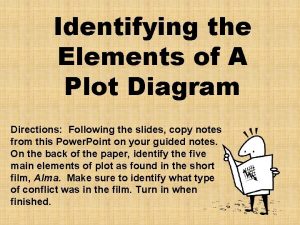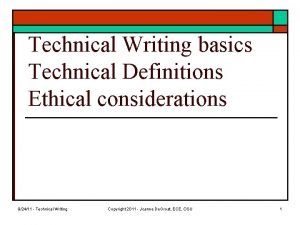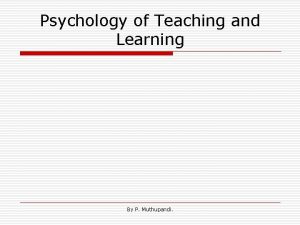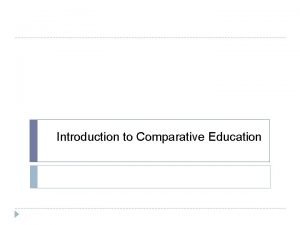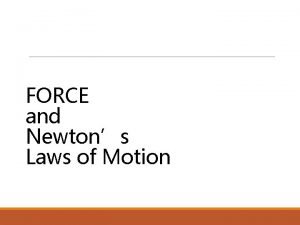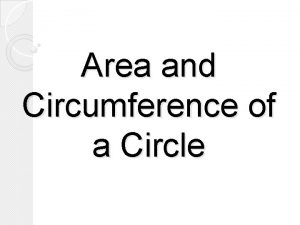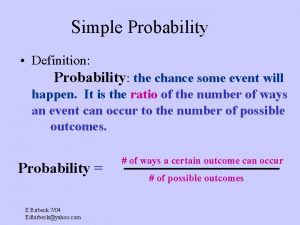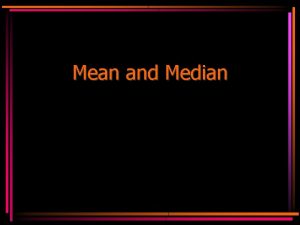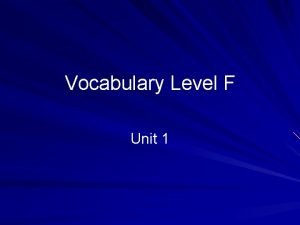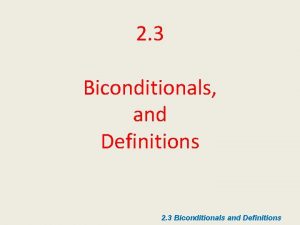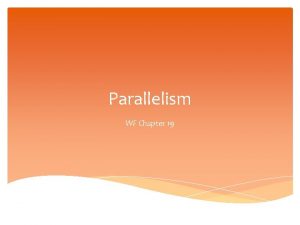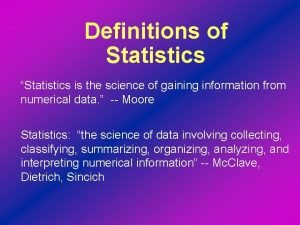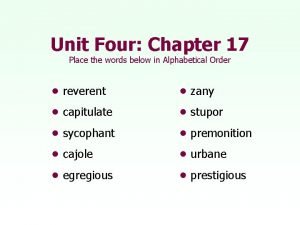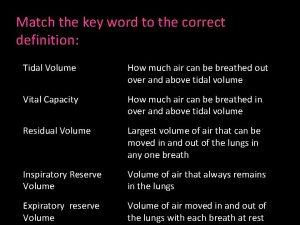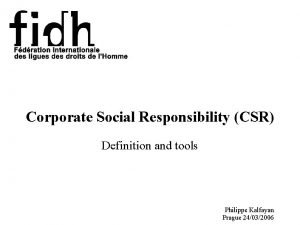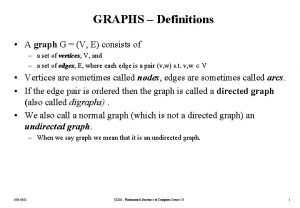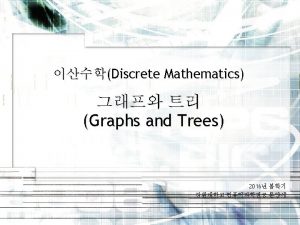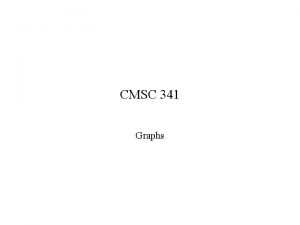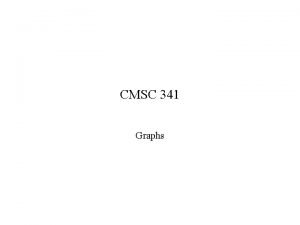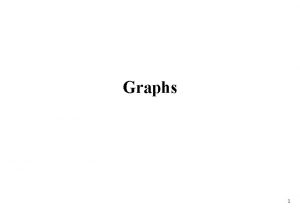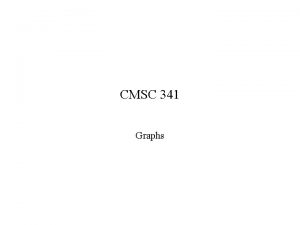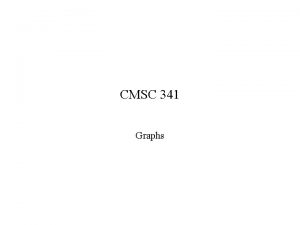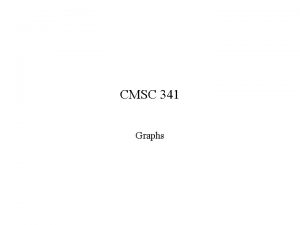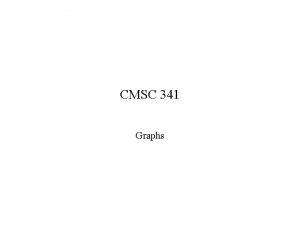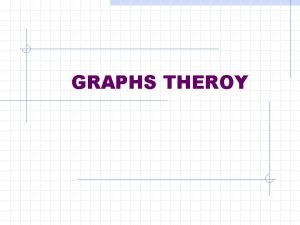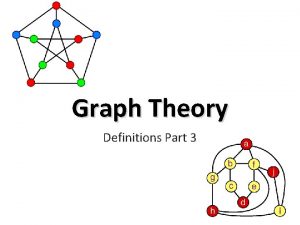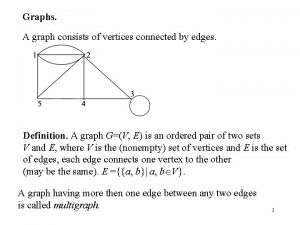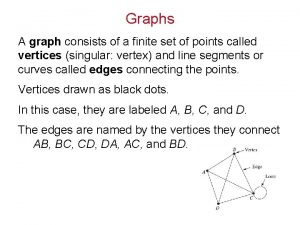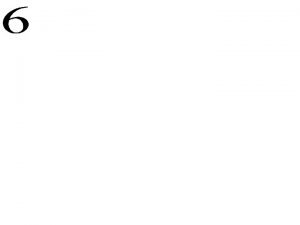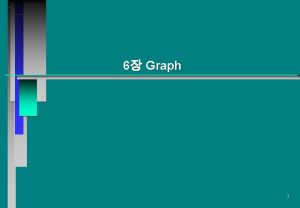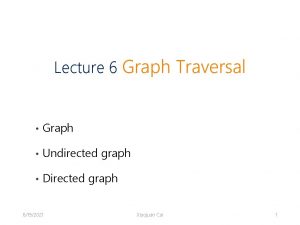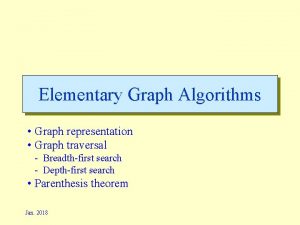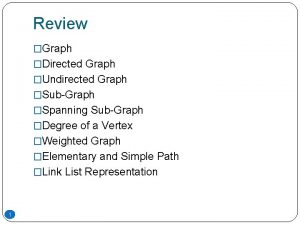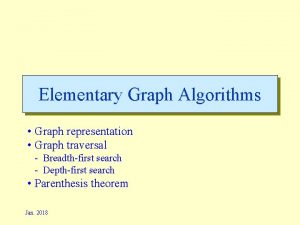GRAPHS Definitions A graph G V E consists




















































- Slides: 52

GRAPHS – Definitions • A graph G = (V, E) consists of – a set of vertices, V, and – a set of edges, E, where each edge is a pair (v, w) s. t. v, w V • Vertices are sometimes called nodes, edges are sometimes called arcs. • If the edge pair is ordered then the graph is called a directed graph (also called digraphs). • We also call a normal graph (which is not a directed graph) an undirected graph. – When we say graph we mean that it is an undirected graph. 3/9/2021 CS 202 - Fundamental Structures of Computer Science II 1

Graph – Definitions • Two vertices of a graph are adjacent if they are joined by an edge. • Vertex w is adjacent to v iff (v, w) E. – In an undirected graph with edge (v, w) and hence (w, v) w is adjacent to v and v is adjacent to w. • A path between two vertices is a sequence of edges that begins at one vertex and ends at another vertex. – i. e. w 1, w 2, …, w. N is a path if (wi, wi+1) E for 1 i . N-1 • A simple path passes through a vertex only once. • A cycle is a path that begins and ends at the same vertex. • A simple cycle is a cycle that does not pass through other vertices more than once. 3/9/2021 CS 202 - Fundamental Structures of Computer Science II 2

Graph – An Example 1 3 2 4 A graph G (undirected) 5 The graph G= (V, E) has 5 vertices and 6 edges: V = {1, 2, 3, 4, 5} E = { (1, 2), (1, 3), (1, 4), (2, 5), (3, 4), (4, 5), (2, 1), (3, 1), (4, 1), (5, 2), (4, 3), (5, 4) } • Adjacent: 1 and 2 are adjacent -- 1 is adjacent to 2 and 2 is adjacent to 1 • Path: 1, 2, 5 ( a simple path), 1, 3, 4, 1, 2, 5 (a path but not a simple path) • Cycle: 1, 3, 4, 1 (a simple cycle), 1, 3, 4, 1 (cycle, but not simple cycle) 3/9/2021 CS 202 - Fundamental Structures of Computer Science II 3

Graph -- Definitions • A connected graph has a path between each pair of distinct vertices. • A complete graph has an edge between each pair of distinct vertices. – A complete graph is also a connected graph. But a connected graph may not be a complete graph. connected 3/9/2021 disconnected CS 202 - Fundamental Structures of Computer Science II complete 4

Directed Graphs • If the edge pair is ordered then the graph is called a directed graph (also called digraphs). • Each edge in a directed graph has a direction, and each edge is called a directed edge. • Definitions given for undirected graphs apply also to directed graphs, with changes that account for direction. • Vertex w is adjacent to v iff (v, w) E. – i. e. There is a direct edge from v to w – w is successor of v – v is predecessor of w • A directed path between two vertices is a sequence of directed edges that begins at one vertex and ends at another vertex. – i. e. w 1, w 2, …, w. N is a path if (wi, wi+1) E for 1 i . N-1 3/9/2021 CS 202 - Fundamental Structures of Computer Science II 5

Directed Graphs • A cycle in a directed graph is a path of length at least 1 such that w 1 = w N. – This cycle is simple if the path is simple. – For undirected graphs, the edges must be distinct • A directed acyclic graph (DAG) is a type of directed graph having no cycles. • An undirected graph is connected if there is a path from every vertex to every other vertex. • A directed graph with this property is called strongly connected. – If a directed graph is not strongly connected, but the underlying graph (without direction to arcs) is connected then the graph is weakly connected. 3/9/2021 CS 202 - Fundamental Structures of Computer Science II 6

Directed Graph – An Example 1 3 2 4 5 The graph G= (V, E) has 5 vertices and 6 edges: V = {1, 2, 3, 4, 5} E = { (1, 2), (1, 4), (2, 5), (4, 5), (3, 1), (4, 3) } • Adjacent: 2 is adjacent to 1, but 1 is NOT adjacent to 2 • Path: 1, 2, 5 ( a directed path), • Cycle: 1, 4, 3, 1 (a directed cycle), 3/9/2021 CS 202 - Fundamental Structures of Computer Science II 7

Weighted Graph • We can label the edges of a graph with numeric values, the graph is called a weighted graph. 8 1 10 6 3 5 3 8 1 3 3/9/2021 7 4 10 5 2 6 3 5 Weighted (Undirect) Graph 2 4 7 CS 202 - Fundamental Structures of Computer Science II Weighted Directed Graph 5 8

Graph Implementations • The two most common implementations of a graph are: – Adjacency Matrix • A two dimensional array – Adjacency List • For each vertex we keep a list of adjacent vertices 3/9/2021 CS 202 - Fundamental Structures of Computer Science II 9

Adjacency Matrix • An adjacency matrix for a graph with n vertices numbered 0, 1, . . . , n-1 is an n by n array matrix such that matrix[i][j] is 1 (true) if there is an edge from vertex i to vertex j, and 0 (false) otherwise. • When the graph is weighted, we can let matrix[i][j] be the weight that labels the edge from vertex i to vertex j, instead of simply 1, and let matrix[i][j] equal to instead of 0 when there is no edge from vertex i to vertex j. • Adjacency matrix for an undirected graph is symmetrical. – i. e. matrix[i][j] is equal to matrix[j][i] • Space requirement O(|V|2) • Acceptable if the graph is dense. 3/9/2021 CS 202 - Fundamental Structures of Computer Science II 10

Adjacency Matrix – Example 1 A directed graph 3/9/2021 Its adjacency matrix CS 202 - Fundamental Structures of Computer Science II 11

Adjacency Matrix – Example 2 An Undirected Weighted Graph 3/9/2021 CS 202 - Fundamental Structures of Computer Science II Its Adjacency Matrix 12

Adjacency List • An adjacency list for a graph with n vertices numbered 0, 1, . . . , n-1 consists of n linked lists. The ith linked list has a node for vertex j if and only if the graph contains an edge from vertex i to vertex j. • Adjacency list is a better solution if the graph is sparse. • Space requirement is O(|E| + |V|), which is linear in the size of the graph. • In an undirected graph each edge (v, w) appears in two lists. – Space requirement is doubled. 3/9/2021 CS 202 - Fundamental Structures of Computer Science II 13

Adjacency List – Example 1 A directed graph 3/9/2021 Its Adjacency List CS 202 - Fundamental Structures of Computer Science II 14

Adjacency List – Example 2 An Undirected Weighted Graph 3/9/2021 Its Adjacency List CS 202 - Fundamental Structures of Computer Science II 15

Adjacency Matrix vs Adjacency List • Two common graph operations: 1. Determine whethere is an edge from vertex i to vertex j. 2. Find all vertices adjacent to a given vertex i. • • An adjacency matrix supports operation 1 more efficiently. An adjacency list supports operation 2 more efficiently. • An adjacency list often requires less space than an adjacency matrix. – – 3/9/2021 Adjacency Matrix: Space requirement is O(|V|2) Adjacency List : Space requirement is O(|E| + |V|), which is linear in the size of the graph. Adjacency matrix is better if the graph is dense (too many edges) Adjacency list is better if the graph is sparse (few edges) CS 202 - Fundamental Structures of Computer Science II 16

Graph Traversals • A graph-traversal algorithm starts from a vertex v, visits all of the vertices that can be reachable from the vertex v. • A graph-traversal algorithm visits all vertices if and only if the graph is connected. • A connected component is the subset of vertices visited during a traversal algorithm that begins at a given vertex. • A graph-traversal algorithm must mark each vertex during a visit and must never visit a vertex more than once. – Thus, if a graph contains a cycle, the graph-traversal algorithm can avoid infinite loop. • We look at two graph-traversal algorithms: – Depth-First Traversal – Breadth-First Traversal 3/9/2021 CS 202 - Fundamental Structures of Computer Science II 17

Depth-First Traversal • For a given vertex v, the depth-first traversal algorithm proceeds along a path from v as deeply into the graph as possible before backing up. • That is, after visiting a vertex v, the depth-first traversal algorithm visits (if possible) an unvisited adjacent vertex to vertex v. • The depth-first traversal algorithm does not completely specify the order in which it should visit the vertices adjacent to v. – We may visit the vertices adjacent to v in sorted order. 3/9/2021 CS 202 - Fundamental Structures of Computer Science II 18

Depth-First Traversal – Example • A depth-first traversal of the graph starting from vertex v. • Visit a vertex, then visit a vertex adjacent to that vertex. • If there is no unvisited vertex adjacent to visited vertex, back up to the previous step. 3/9/2021 CS 202 - Fundamental Structures of Computer Science II 19

Recursive Depth-First Traversal Algorithm dft(in v: Vertex) { // Traverses a graph beginning at vertex v // by using depth-first strategy // Recursive Version Mark v as visited; for (each unvisited vertex u adjacent to v) dft(u) } 3/9/2021 CS 202 - Fundamental Structures of Computer Science II 20

Iterative Depth-First Traversal Algorithm dft(in v: Vertex) { // Traverses a graph beginning at vertex v // by using depth-first strategy: Iterative Version s. create. Stack(); // push v into the stack and mark it s. push(v); Mark v as visited; while (!s. is. Empty()) { if (no unvisieted vertices are adjacent to the vertex on the top of stack) s. pop(); // backtrack else { Select an unvisited vertex u adjacent to the vertex on the top of the stack; s. push(u); Mark u as visited; } } } 3/9/2021 CS 202 - Fundamental Structures of Computer Science II 21

Trace of Iterative DFT – starting from vertex a 2 1 3 8 9 6 4 5 7 3/9/2021 CS 202 - Fundamental Structures of Computer Science II 22

Breath-First Traversal • After visiting a given vertex v, the breadth-first traversal algorithm visits every vertex adjacent to v that it can before visiting any other vertex. • The breath-first traversal algorithm does not completely specify the order in which it should visit the vertices adjacent to v. – We may visit the vertices adjacent to v in sorted order. 3/9/2021 CS 202 - Fundamental Structures of Computer Science II 23

Breath-First Traversal – Example • A breath-first traversal of the graph starting from vertex v. • Visit a vertex, then visit all vertices adjacent to that vertex. 3/9/2021 CS 202 - Fundamental Structures of Computer Science II 24

Iterative Breath-First Traversal Algorithm bft(in v: Vertex) { // Traverses a graph beginning at vertex v // by using breath-first strategy: Iterative Version q. create. Queue(); // add v to the queue and mark it q. enqueue(v); Mark v as visited; while (!q. is. Empty()) { q. dequeue(w); for (each unvisited vertex u adjacent to w) { Mark u as visited; q. enqueue(u); } } } 3/9/2021 CS 202 - Fundamental Structures of Computer Science II 25

Trace of Iterative BFT – starting from vertex a 2 1 5 9 4 6 8 7 3 3/9/2021 CS 202 - Fundamental Structures of Computer Science II 26

Topological Sorting • A directed graph without cycles has a natural order. – That is, vertex a precedes vertex b, which precedes c – For example, the prerequisite structure for the courses. • In which order we should visit the vertices of a directed graph without cycles so that we can visit vertex v after we visit its predecessors. – This is a linear order, and it is known as topological order. • For a given graph, there may be more than one topological order. • Arranging the vertices into a topological order is called topological sorting. 3/9/2021 CS 202 - Fundamental Structures of Computer Science II 27

Topological Order – Example Some Topological Orders for this graph: a, g , d, b, e, c, f a, b, g, d, e, f, c 3/9/2021 CS 202 - Fundamental Structures of Computer Science II 28

Topological Order – Example (cont. ) The graph arranged according to the topological orders (a) a, g, d, b, e, c, f and (b) a, b, g, d, e, f, c 3/9/2021 CS 202 - Fundamental Structures of Computer Science II 29

Simple Topological Sorting Algorithm 1 – top. Sort 1(in the. Graph: Graph, out a. List: List) { // Arranges the vertices in graph the. Graph into a // toplogical order and places them in list a. List n = number of vertices in the. Graph; for (step=1 through n) { select a vertex v that has no successors; a. List. insert(1, v); Delete from the. Graph vertex v and its edges; } } 3/9/2021 CS 202 - Fundamental Structures of Computer Science II 30

Trace of top. Sort 1 3/9/2021 CS 202 - Fundamental Structures of Computer Science II 31

DFS Topological Sorting Algorithm – top. Sort 2(in the. Graph: Graph, out a. List: List) { // Arranges the vertices in graph the. Graph into atoplogical order and // places them in list a. List s. create. Stack(); for (all vertices v in the graph) if (v has no predecessors) { s. push(v); Mark v as visited; } while (!s. is. Empty()) { if (all vertices adjacent to the vertex on the top of stack have been visited) { s. pop(v); a. List. insert(1, v); } else { Select an unvisited vertex u adjacent to the vertex on the top of the stack; s. push(u); Mark u as visited; } } } 3/9/2021 CS 202 - Fundamental Structures of Computer Science II 32

Trace of top. Sort 2 3/9/2021 CS 202 - Fundamental Structures of Computer Science II 33

Spanning Trees • • A tree is a special kind of undirected graph. That is, a tree is a connected undirected graph without cycles. All all trees are graphs, not all graphs are trees. A spanning tree of a connected undirected graph G is a sub-graph of G that contains all of G’s vertices and enough of its edges to form a tree. • There may be several spanning trees for a given graph. • If we have a connected undirected graph with cycles, and we remove edges until there are no cycles to obtain a spanning tree. 3/9/2021 CS 202 - Fundamental Structures of Computer Science II 34

A Spanning Tree Remove dashed lines to obtain a spanning tree 3/9/2021 CS 202 - Fundamental Structures of Computer Science II 35

Cycles? Observations about graphs: 1. A connected undirected graph that has n vertices must have at leas n-1 edges. 2. A connected undirected graph that has n vertices and exactly n-1 edges cannot contain a cycle. 3. A connected undirected graph that has n vertices and more than n-1 edges must contain a cycle. Connected graphs that each have four vertices and three edges 3/9/2021 CS 202 - Fundamental Structures of Computer Science II 36

DFS Spanning Tree dfs. Tree(in v: vertex) { // Forms a spanning tree for a connected undirected graph // beginning at vertex v by using depth-first search; // Recursive Version Mark v as visited; for (each unvisited vertex u adjacent to v) { Mark the edge from u tu v; dfs. Tree(u); } } 3/9/2021 CS 202 - Fundamental Structures of Computer Science II 37

DFS Spanning Tree – Example The DFS spanning tree rooted at vertex a 3/9/2021 CS 202 - Fundamental Structures of Computer Science II 38

BFS Spanning tree bfs. Tree(in v: vertex) { // Forms a spanning tree for a connected undirected graph // beginning at vertex v by using breath-first search; // Iterative Version q. create. Queue(); q. enqueue(v); Mark v as visited; while (!q. is. Empty()) { q. dequeue(w); for (each unvisited vertex u adjacent to w) { Mark u as visited; Mark edge between w and u; q. enqueue(u); } } } 3/9/2021 CS 202 - Fundamental Structures of Computer Science II 39

BFS Spanning tree – Example The BFS spanning tree rooted at vertex a 3/9/2021 CS 202 - Fundamental Structures of Computer Science II 40

Minimum Spanning Tree • If we have a weighted connected undirected graph, the edges of each of its spanning tree will also be associated will be costs. • The cost of a spanning tree is the sum of the costs the edges in the spanning tree. • A minimum spanning tree of a connected undirected graph has a minimal edge-weight sum. – A minimum spanning tree of a connected undirected may not be unique. – Although there may be several minimum spanning trees for a particular graph, their costs are equal. • Prim’s algorithm finds a minimum spanning tree that begins any vertex. – Initially, the tree contains only the starting vertex. – At each stage, the algorithm selects a least-cost edge from among those that begin with a vertex in the tree and end with a vertex not in the tree. – The selected vertex and least-cost edge are added to the tree. 3/9/2021 CS 202 - Fundamental Structures of Computer Science II 41

Prim’s Algorithm prims. Algorithm(in v: Vertex) { // Determines a minimum spanning tree for a weighted, // connected, undirected graph whose weights are // nonnegative, beginning with any vertex. Mark vertex v as visited and include it in the minimum spanning tree; while (there are unvisited vertices) { Find the least-cost edge (v, u) from a visited vertex v to some unvisited vertex u; Mark u as visited; Add the vertex u and the edge (v, u) to the minimum spanning tree; } } 3/9/2021 CS 202 - Fundamental Structures of Computer Science II 42

Prim’s Algorithm – Trace A weighted, connected, undirected graph 3/9/2021 CS 202 - Fundamental Structures of Computer Science II 43

Prim’s Algorithm – Trace (cont. ) beginning at vertex a 3/9/2021 CS 202 - Fundamental Structures of Computer Science II 44

Prim’s Algorithm – Trace (cont. ) 3/9/2021 CS 202 - Fundamental Structures of Computer Science II 45

Prim’s Algorithm – Trace (cont. ) 3/9/2021 CS 202 - Fundamental Structures of Computer Science II 46

Shortest Paths • The shortest path between two vertices in a weighted graph has the smallest edge-weight sum. • Dijkstra’s shortest-path algorithm finds the shortest paths between vertex 0 (a given vertex) and all other vertices. • For Dijkstra’s algorithm, we should use the adjacency matrix representation for a graph for a better performance. 3/9/2021 CS 202 - Fundamental Structures of Computer Science II 47

Shortest Paths A Weighted Directed Graph 3/9/2021 CS 202 - Fundamental Structures of Computer Science II Its Adjacency Matrix 48

Dijkstra’s Shortest-Path Algorithm shortest. Path(in the. Graph, in weight: Weight. Array) { // Finds the minimum-cost paths between an origin vertex (vertex 0) // and all other vertices in a weighted directed graph the. Graph; // the. Graph’s weights are nonnegative Create a set vertex. Set that contains only vertex 0; n = number of vertices in the Graph; // Step 1 for (v=0 through n-1) weight[v] = matrix[0][v]; // Steps 2 through n for (step=2 through n) { Find the smallest weight[v] such that v is not in vertex. Set; Add v to vertex. Set; for (all vertices u not in vertex. Set) if (weight[u] > weight[v]+matrix[v][u]) weigth[u] = weight[v]+matrix[v][u]; } } 3/9/2021 CS 202 - Fundamental Structures of Computer Science II 49

Dijkstra’s Shortest-Path Algorithm – Trace 3/9/2021 CS 202 - Fundamental Structures of Computer Science II 50

Dijkstra’s Shortest-Path Algorithm – Trace (cont. ) 3/9/2021 CS 202 - Fundamental Structures of Computer Science II 51

Dijkstra’s Shortest-Path Algorithm – Trace (cont. ) 3/9/2021 CS 202 - Fundamental Structures of Computer Science II 52
 Graphs that compare distance and time are called
Graphs that compare distance and time are called Graphs that enlighten and graphs that deceive
Graphs that enlighten and graphs that deceive Degree and leading coefficient
Degree and leading coefficient State testing and testability tips
State testing and testability tips Terminologi
Terminologi Graph consists of a?
Graph consists of a? Algorithmic graph theory and perfect graphs
Algorithmic graph theory and perfect graphs Representing graphs and graph isomorphism
Representing graphs and graph isomorphism Networks and graphs circuits paths and graph structures
Networks and graphs circuits paths and graph structures Representing graphs and graph isomorphism
Representing graphs and graph isomorphism Inverse variation
Inverse variation Resource allocation graph and wait for graph
Resource allocation graph and wait for graph Bridge graph
Bridge graph Characteristics of hazards
Characteristics of hazards Match the crimes to their definitions
Match the crimes to their definitions Leadership in management definition
Leadership in management definition Individual psychotherapy definition
Individual psychotherapy definition Match the terms with their definition
Match the terms with their definition The story comes to reasonable ending
The story comes to reasonable ending Technical definition example
Technical definition example Health education defintion
Health education defintion Complete the definitions with the words below
Complete the definitions with the words below Educational psychology meaning
Educational psychology meaning Need of comparative education
Need of comparative education Newtons laws definitions
Newtons laws definitions Elements of a story resolution
Elements of a story resolution Area to circumference
Area to circumference Probability odds
Probability odds Definitions of solution
Definitions of solution Cscmp meaning
Cscmp meaning Objectives of financial control
Objectives of financial control Mathmatical mode
Mathmatical mode Vocabulary level f unit 1
Vocabulary level f unit 1 Operating system definitions
Operating system definitions The 8 news values
The 8 news values 7 habits definitions
7 habits definitions Ap statistics definitions
Ap statistics definitions What is scaled down teaching
What is scaled down teaching Unit 3 lesson 2 biconditionals and definitions
Unit 3 lesson 2 biconditionals and definitions Parallelism for paired ideas
Parallelism for paired ideas Accounting management definition
Accounting management definition Definitions of statistics
Definitions of statistics A quick primer
A quick primer Meaning and definition of cost accounting
Meaning and definition of cost accounting Match the definitions with the words
Match the definitions with the words Reverent
Reverent What is a stagnator in entrepreneurship
What is a stagnator in entrepreneurship Undefined terms definition
Undefined terms definition Match the word with the correct definition
Match the word with the correct definition Corporate responsibility definition
Corporate responsibility definition Meaning of environmental
Meaning of environmental Definitions of attitude
Definitions of attitude A slender tool attached to the needle clamp
A slender tool attached to the needle clamp




